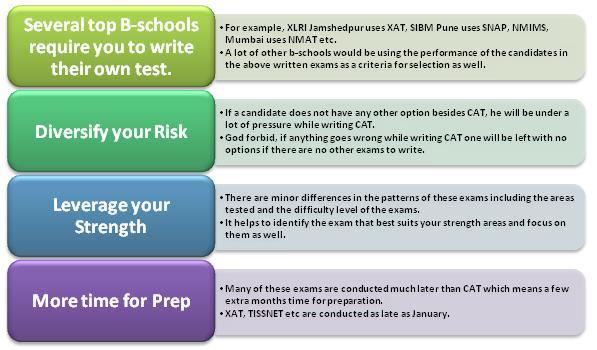About MBA
IIM Admission Criteria
B-School Selection
MBA Entrances National Level
Exam Patterns and Details
| Exam Name | Exam Pattern | Comp based/PP | Additional Points |
|---|---|---|---|
| CAT | Three sections VA/RC, DI/LR, and QA with 24, 20, and 22 questions respectively. Each section has a 40 mins time limit. Most questions are MCQs with some Non-MCQ questions, which do not have negative marking. | Computer Based | You do not need to apply separately to most IIMs. However, for other institutes using CAT scorecards, applications need to be submitted separately. |
| XAT | The exam consists of Quantitative Ability, Verbal & Logical Ability, Decision Making, and General Awareness sections. | Computer Based | General Awareness performance is not used for shortlisting candidates for the GDPI round. |
| SNAP | 60 Questions – 15 in General English, 20 in QA, DI/DS, and 25 in Analytical and Logical Reasoning. Total duration is 1 hour. | Computer Based | Applicants must apply separately to MBA programs of choice. Rs 1000 is charged per program. The exam can be taken up to 3 times, with the best score considered. |
| CMAT | 100 Questions – 20 each in QA & DI, LR, VA, GA, and Innovation & Entrepreneurship. | Computer Based | It is conducted once in April/May. |
| NMAT | 108 Questions in 120 minutes. LS – 36 Q in 28 min; QS – 36 Q in 52 min; LR – 36 Q in 40 min. | Computer Based | A candidate can take the test up to three times within the test window. |
| MICAT | Consists of 6 sections: Psychometric (P), Verbal Ability (VA), Quantitative Ability (QA), General Awareness (GA), Divergent-Convergent Reasoning (DCR), and Descriptive Test (DT). | Computer Based | It is conducted twice, and the best score of the two attempts is considered. |
| MAT | 150 Questions – Language Comprehension (30), Intelligence & Critical Reasoning (30), Mathematical Skills (30), Data Analysis & Sufficiency (30), Economic & Business Environment (30). | Both | - |
| IBSAT | 140 Questions in Verbal Ability (50), Reading Comprehension (30), Quantitative Ability (30), and Data Adequacy/Data Interpretation (30) to be answered in 120 minutes. | Computer Based | - |
Opportunities Beyond CAT - Other Management Entrance Tests
The CAT is one of the most popular management entrance exams, but there are several other important exams that students should consider. Collectively referred to as OMETs (Other Management Entrance Tests), these include exams like XAT, SNAP, CMAT, MAT, as well as institute-specific exams such as NMAT, TISSNET, IBSAT, and IIFT.
There are several reasons why candidates should consider taking these exams in addition to the CAT:

It is important to be aware of these exams and prepare accordingly, as their patterns often differ from that of the CAT. Below are some of the major OMETs that will be conducted this year.
XAT
XAT is the second most popular management entrance examination after CAT. XAT is conducted by XLRI,Jamshedpur on behalf of Xavier Association of Management Institutes.Apart from XLRI, which is one of the top-5 B-schools in India according to latest rankings by various independent agencies, XAT scores are used by more than 100 institutes across India. XAT is usually conducted in the first week of January.
Symbiosis National Aptitude Test (SNAP)
SNAP is an aptitude test conducted by the Symbiosis society as a first entry requirement for all the B schools under Symbiosis International University which has 15 B schools under its umbrella, 5 General management and the others- sectoral or specialized MBAs. The list of institutes includes SIBM Pune, SCMHRD Pune, SIBM Bangalore, SIIB Pune etc. The exam is considered a must for MBA aspirants thanks to this eclectic mix of colleges using its scorecard as a part of their selection processes.
Management Aptitude Test (MAT)
Exams Conducted By Individual Institutes
The following stand-alone tests are conducted by various B-schools for admission of candidates into their MBA programmes.
1. IBSAT2. MICAT

